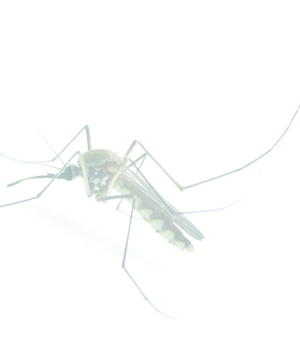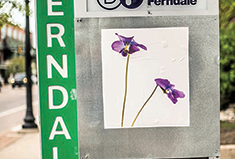Know The Buzz : Protecting Residents Against Mosquito-Borne Diseases
Story by: Sara E. Teller
FERNDALE RESIDENTS AND THOSE IN SURROUNDING COMMUNITIES may be noticing public awareness signs that feature mosquitos popping up in their neighborhoods. What’s this all about, and is there cause for concern?
The signs are meant to announce the potential for mosquitos to carry the West Nile Virus (WNV). WNV is most often spread to humans after they are bit by an infected insect. The infected mosquito carries the virus after biting a bird with WNV.
While most who are infected with WNV will experience little to no symptoms, the virus can cause illness and even death. Approximately one in 150 people infected will develop severe illness. Symptoms of the severe version can include high fever, headache, neck stiffness, stupor, disorientation, coma, tremors, convulsions, muscle weakness, vision loss, numbness and paralysis.
Up to 20 per cent of people who become infected with WNV will display some symptoms within three to 14 days, including fever, headache, body aches, nausea, vomiting, and sometimes swollen lymph glands or a skin rash on the chest, stomach and back.
Unfortunately, there is no vaccine or treatment for WNV. Illness may last weeks to months, even in healthy persons. Those who are symptomatic may require intravenous fluids, help with breathing and nursing care. Severe cases require hospitalization. Pregnant women are encouraged to seek immediate medical attention if they develop symptoms that could be linked to the virus.
The Oakland County Health Division (OCHD) leads the county’s proactive response against the risks posed by WNV and other mosquito-borne diseases, such as the Zika virus. “We have had a WNV prevention plan since 2003,” said Johanna Cassise of the OCHD. There were recently three confirmed cases of WNV in Michigan, including those in Montcalm County, as well as Oakland and Macomb Counties.
“Whenever mosquitoes are active, there is a risk of getting WNV. The risk is highest from late July through September,” Johanna explained. “Currently, one confirmed case of WNV in Oakland County this year.”
The Oakland County Health Division administers funding allocated by County Executive L. Brooks Patterson and the Oakland County Board of Commissioners to employ preventative efforts in conjunction with the county’s 62 cities, villages, and townships (CVTS). “These funds are allocated to participating CVTs and support OCHD’s WNV prevention plan aimed at public education about personal protection and reduction of mosquito breeding habitats,” said Johanna.
This year, 45 CVTs have joined the Health Division in implementing protective measures designed to educate residents on the potential harm of WNV. Almost $200 thousand dollars, the amount that is allocated annually for prevention activities, will be distributed among those participating. The funds will pay for:
● Larviciding municipal catch basins to eliminate mosquito larvae and halt reproduction.
● Distributing personal-use mosquito repellent at outdoor community events.
● Implementing public-awareness campaigns about protecting against WNV and controlling mosquitos. Funding through Michigan Department of Health and Human Services (MDHHS) enhanced educational messaging throughout the county.
Part of the current public awareness campaign includes signs featuring Know the Buzz. “Signs were distributed to interested CVTs participating in the reimbursement program and the Oakland County Senior Advisory Council,” Johanna said. “City of Ferndale is one of the municipalities displaying the signs.”
THE OCHD RECOMMENDS SEVERAL WAYS TO PREVENT WNV. “The best way to prevent WNV infection is to prevent mosquito bites,” according to Johanna.
To best protect against bites, residents should use Environmental Protection Agency (EPA)-registered insect repellant. All EPA-registered insect repellants are evaluated for safety and effectiveness, and will contain DEET, picaridin, IR3535, Oil of Lemon Eucalyptus or paramenthanediol as the active ingredient. Repellents containing a higher percentage of the active ingredient typically provide longer-lasting protection.
It is also important to get rid of breeding sites. To do so, homeowners should remove any standing water. Some tips include turning over any type of container that can collect fluid. Once a week, empty out items that hold water such as tires, buckets, planters, toys, pools, birdbaths, pet bowls, flowerpots, and trash containers. Clean clogged roof gutters, particularly if leaves tend to plug up the drains. Treat standing water that cannot be eliminated, such as retention ponds or drainage ditches, with a mosquito larvicide. Mosquito larvicide is easy to use and can be purchased at most home improvement stores.
Individuals should also wear protective clothing such as long-sleeved shirts and pants, especially while outdoors, and limit outdoor activities when-ever mosquitoes are most active, typically late afternoon, dusk to dawn, and in the early morning. Avoid areas where mosquitoes may be present and maintain window and door screens to keep mosquitoes out of homes and buildings. Never prop open doors, allowing for easy entry into the home.
For more information residents can follow @publichealthOC on Facebook, Twitter, and Pinterest. The Health Division encourages everyone to share its prevention messages. Additional information can also be found at the Mosquito-Borne Disease Information Page at:
www.oakgov.com/health/information/Pages/Mosquito-Borne-Diseases.aspx



